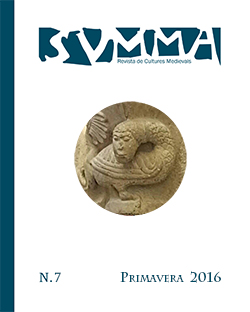Between Heavenly and Earthly Liturgy: The Paintings in the Chapel of the Abbey House of Moissac (end of the 12th Century)
DOI:
https://doi.org/10.1344/Svmma2016.7.2Palabras clave:
Moissac, abbot, Tree of Jesse, Christ Pantocrator, liturgy, sacred space, private space of devotionResumen
A wall-painting programme of great quality dating from the late twelfth century is extant in the late eleventh-century lower chapel of the medieval tower located northeast of the apse of the abbey church of Moissac. It is possible that this area belonged to the hôtel Sainte-Foy, which fourteenth-century texts called the aula of the abbot. On the west wall of the chapel, a Tree of Jesse stretches across the barrel vault. The prophets, originally twelve, complete the central image. They are connected to the Apostolic College associated with the Christ Pantocrator placed next to depiction of Christ’s lineage.Besides the semantic richness of each image, their association in the space of the chapel is particularly significant. The polysemic programme evokes not only the continuity between the Old and New Testaments, but also, especially, the reaffirmation of the dual nature of Christ in the liturgical space and the meaning of the Church of Christ.
Upon their completion, the paintings of the chapel were the subject of particular attention: they were enriched with glass and metal cabochons, precious pigments, and gold, generating effects for the benefit of the viewers-actors who stood in this space.
We will look into both the meaning of these images and the staging of the sacred in a place of private devotion that was reserved for the abbot and the prestigious guests of the abbey.
Descargas
Publicado
Número
Sección
Licencia
Derechos de autor 2016 Cécile Voyer

Esta obra está bajo una licencia internacional Creative Commons Atribución-NoComercial-SinDerivadas 4.0.
Los autores que publican en esta revista están de acuerdo con los siguientes términos:
a. Los autores conservan los derechos de autoría y otorgan a la revista el derecho de primera publicación de la obra. SVMMA Revista de Culturas Medievales publica con una licencia de Reconocimiento-NoComercial-CompartirIgual 3.0 España de Creative Commons, la cual permite compartir la obra con terceros, siempre que éstos reconozcan su autoría, sin ánimo de lucro y compartan la obra derivada en las mismas condiciones.
b. Los autores son libres de hacer acuerdos contractuales adicionales independientes para la distribución no exclusiva de la versión de la obra publicada en la revista (como la publicación en un repositorio institucional o en un libro), siempre que se reconozca su publicación inicial en esta revista.
c. Se anima a los autores a publicar su obra en línea (en repositorios institucionales o en su página web, por ejemplo), con el objetivo de conseguir intercambios productivos y hacer que la obra obtenga más citaciones (véase The Effect of Open Access, en inglés).





